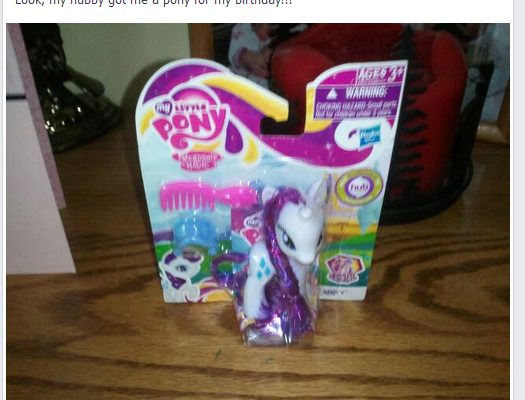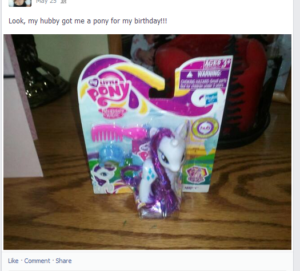Am I the only one who just noticed that it’s Wednesday? The holiday week with the free day is completely screwing me up.
Just to make this a relevant post:
Spend less!
Save more!
Invest!
Wee!
The no-pants guide to spending, saving, and thriving in the real world.

For the past couple of years, my daughters have been riding in horse shows with a local saddle club. We’ve been lucky in that my wife’s cousin has let us borrow her horse for the shows, so costs have been minimal.
Unfortunately, that horse isn’t available this year. We knew that a few months ago, so the plan was to take a year off from the shows and focus on lessons, to get the girls some real skills. We found a great instructor at a stable about 30 miles from our house. Since we live less than two miles from the border of the biggest city in the state, that’s a comparatively short drive.
We pay her $200 per month for 1 lesson per week for both girls. They each get 30-45 minutes on the horse during each lesson.
Now that show season has started, the plan seems to have changed. The girls will be riding a different borrowed pony tomorrow. The shows cost about $50 for registration, lunch, and gas. Our club has 1 show per month, but my wife has assured me they’ll only be hitting three shows this season and limiting the number of events to keep the cost down.
The direct costs aren’t too bad, but there’s a problem with keeping-up-with-the-Joneses accessorizing. Vests and boots and helmets and belts and shirts, oh my.
I’d guess our costs for the summer will be $300 per month.
One thing we’ve been considering is buying a pony. We can get an older pony for around $500-1000. Older is good because they are calmer and slower. Boarding the thing will cost another $200 per month. We’ve been slowly accumulating the stuff to own a horse, so I’m guessing the “OMG, he let me buy a horse, now I need X” shopping bill will come to around $1500, but I’ll figure $2000 to be safe. We already have a trailer, a saddle, blankets, buddy-straps, combs, brushes, buckets, rakes, shovels, and I-bought-this-but-I-will-just-put-it-in-the-pile-of-horse-stuff-so-Jason-will-never-notice stuff. We’re certainly close to being ready to buy.
(FYI: If you’re starting from scratch, don’t think you’re going to get into horse ownership for less than $10,000 the first year, and that’s being a very efficient price-shopper.)
So we’re looking at $5400 for a horse, gear, and boarding the first year. If we cancel the lessons, by spring we’d have $2000 of that saved and most of the rest can be bought over time.
On the other hand, if we go that route, we’ll never save enough to buy the hobby farm we’re looking for.
Decisions, decisions. I should just buy a new motorcycle. Within a year, I win financially.
Car insurance is mandatory in Colorado. Colorado law on car insurance changed in 2003 when the state changed to a fault-based system from a no-fault system. Even more requirements were added in 2009 for drivers, namely, a mandatory $5,000 in medical payments coverage.
Many of the other changes made to Colorado car insurance requirements were made to help prevent claim abuses and reduce the cost of insurance premiums for drivers in the city. The ‘tort’ or fault-based system requires that fault must be established before a claim is paid by an insurance company.
According to data released by the National Association of Insurance Commissioners, the average cost of auto insurance in Colorado was $777. This is way below the national average of $841 and far below the most expensive state, New Jersey, which had an average expenditure of $1,254 in annual premiums.
Colorado Insurance requirements
The state requires all drivers to have liability coverage at the least. This ensures that the other party and their property will be compensated in an accident that is your fault. According to insurance-comparison site, CoverHound, the minimum coverage for car insurance in Colorado should include:
Additional car insurance
Having insurance coverage meeting the minimum requirements of the law in Colorado will save you from being arrested for inadequate insurance. However, your insurance may not provide you with adequate coverage in case of an accident. Therefore, it’s important to consider the following car insurance options.
While car insurance is a mandatory in Colorado, several drivers still drive without auto insurance. Figures released by the Insurance Research Council estimate that 16.2 percent of motorists in the state are uninsured. This is slightly above the 12.6 percent national average. The scary thing about not having this coverage is you never know when you’re going to get in an accident, let alone an accident with someone who’s underinsured, or uninsured altogether. As you can probably guess, if someone isn’t willing to pay an insurance premium to protect their financial means, they probably don’t have much financial means to protect in the first place, thus leaving you destitute in the event of an accident, regardless of fault. Bottom line: uninsured/underinsured motorist coverage protects your expenses in this situation.
Due to the aforementioned legislation passed in 2009, insurance providers are required to offer motorists $5,000 in med pay coverage as part of their insurance coverage. This is offered as part of every car insurance policy, and can be adjusted in $1,000 increments. You however, have the choice of opting out, but you have to send a rejection form. You can also choose to up your coverage to as much as $100,000.
Liability coverage ensures that the other party’s expenses are covered in the event you cause an accident, but what about damage to your own car? Collision coverage takes care of any damages to your car regardless of who’s at fault. The insurance also covers you for damage caused by hitting other objects with your car, such as a tree, or streetlight.
This ensures that you are covered for any damage that is caused to your car that doesn’t involve a collision (e.g. fire, falling objects, flood and hail). It also provides cover for the loss of your car through theft and other perils such as explosions.
If you purchase your car through a loan, your lender may require you to take out a comprehensive coverage policy. You can choose to have a higher deductible in order to reduce the cost of your premium.
Cost of violations
There are various penalties set by the state to ensure that motorists have adequate insurance. You may be penalized for failing to provide evidence of insurance or for purchasing inadequate insurance. Some of the penalties and fines include:
It is important to understand your state laws and your own financial situation when choosing insurance. Your policy should not only meet state law requirements but your personal requirements as well. If it doesn’t, then what’s the point of having it in the first place?
This is a guest post.
Today, I discovered our AOL billing information. Turns out we’ve been paying for dial-up via automatic bill paying that we thought we cancelled in 2000. $1,800 later, we called to cancel. Customer service congratulated us on being loyal members for over 13 years. FML -Jay

I am a huge fan of automating my finances. My paycheck is direct-deposited. My savings are automatically transferred from my checking account to my savings account. Almost every bill I receive regularly is set up as an automatic payment in my bank’s bill-pay system. I even have my debt snowball automated.
The only question left is whether it’s possible to automate too far. Can you automate past the point of benefit, straight into detriment? The primary benefit of automation is knowing that you can’t forget a payment. The other benefit is freeing up your attention. You don’t have to give any focus to paying your bills, freeing you to worry about other things.
The problem with the second benefit is the same as the benefit. If you don’t give your bills any attention, how do you know if there is a problem? If something changes–an extra fee or a mis-keyed payment–you won’t notice because you haven’t been giving the bills any focus.
Sometimes, this means you are paying an extra fee without noticing it. Sometimes, if your due date changes, it can mean late fees. Even if nothing goes wrong, you are missing the opportunity to review what you are paying to ensure your needs are being met as efficiently as possible.
What can you do about it? I put a reminder on my Life Calendar to check my bills each month. I pick one bill each month and try to find a way to save money on it. I review the services to make sure they are what I need and if that doesn’t help, I call and ask for a lower price. If it’s a credit card, I ask for a lower interest rate. For the cable company, I ask if they will match whatever deal they have for new customers.
Every company can do something to keep a loyal customer happy. All you have to do is ask.
Do you automate anything? How do you keep track of it all?

When I was little, the world was amazing. The first snowfall was among the best days of the year. Everything was worth exploring, in hopes of discovering something new and fascinating, and everything was fascinating.
Stepping on a crack had serious implications. The wishbone in a turkey earned its name. Blowing out all of the candles on a birthday cake could change your life. The idea of some dude half a world away, watching you, then sneaking into your house to dish our rewards and punishments wasn’t pervy and sick, it was wonderful.
Then, one day, it all changes.
Somebody–a classmate, a older brother, a neighbor–let’s it slip that Santa isn’t real, and the implications snowball. That day, the magic dies.
Wishing on a star? Over.
The Easter Bunny? Hasenpfeffer.
Growing up to be Superman? Welcome to the rat race.
It’s a sad day when kids stop believing in magic.
I don’t believe in lying to my children, but I also don’t believe in destroying their magic. It’s a balancing act.
When my son was 6, an older boy at daycare tried to kill Santa for him. He was upset.
“Dad, is Santa real?”
“What do you think?”
“I don’t believe in Santa.”
“Okay, I’ll let him know.”
“Nonononononono! Don’t tell him!”
Was it lying? Probably, but he obviously wasn’t ready to stop believing, so I let him continue. A year later, we had the same conversation, but the results were quite different.
“Dad, you’ve always said that you hate lying, so why did you let me believe in Santa?”
So I told him the truth. Magic is a frail thing that’s nearly impossible to reclaim and I wanted him to have that treasure for as long as possible. And, “Now that you know, you are in on the conspiracy. You’ve been drafted. Don’t kill the magic for anyone else.”
It was weird having him help me stuff stockings.
If you’ve got kids(and celebrate Christmas), how do you handle the Santa problem?
It’s a sad day when kids stop believing in Santa Clause, the Tooth Fairy, and fairies.

Not because I enjoy lying to my kids, but because–on the day they stop believing–a piece of their innocence is lost. An unforgettable, valuable part of childhood dies.
Believing in magic is a beautiful thing.
Do you remember the last time you looked around the world with a sense of wonder? When seeing a puppy form in the clouds was a miracle? When the idea of an ant carrying 1000 times its own weight was something worth watching? When the impossible goodness of a fat man squeezing down your chimney fills you with hope instead of making you call 911?
Do I believe in Santa?
Of course not, but I believe the concept of Santa is worthy of my children’s belief. I don’t want them to lose that innocence and wonder.
When my teenager was young, he asked if Santa was real. I responded by asking what he thought. When he told me he didn’t believe, I offered to let Santa know. His panic told me he wasn’t ready to give up the magic.
The day that conversation didn’t cause a panic, he looked hurt, like he’d lost something precious. He had.
His world of magic was gone.
The he asked why I had spent his lifetime lying to him. I told him the truth. I said I couldn’t bear to be the one to shatter his belief in magic before he was ready.
Then, I informed him that he was in on the conspiracy. He was not allowed to ruin it for anyone else. Not his sisters, not his friends.
That Christmas, my little boy helped me stuff stockings, which was an odd feeling.
The magic was over, but we still got to share the magic of his cousins and sisters.